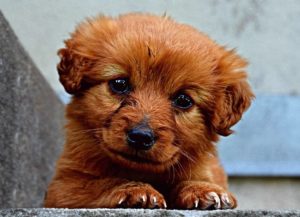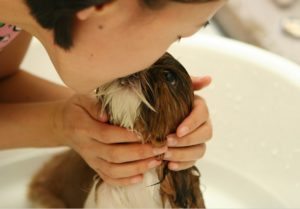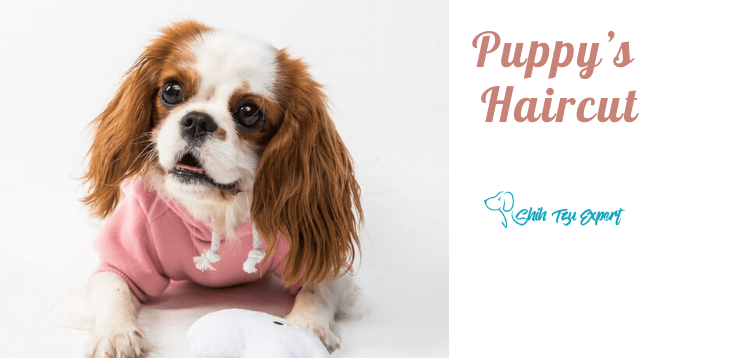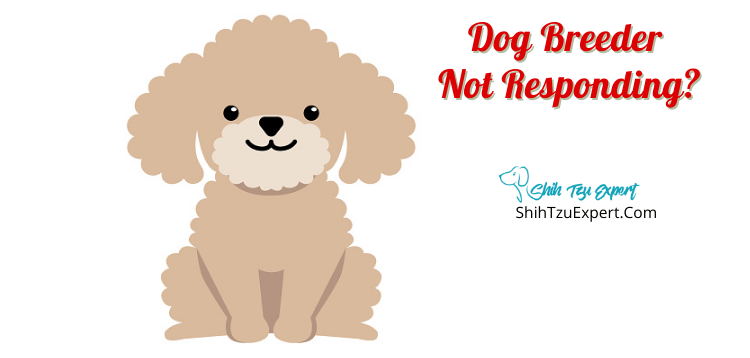When Can I Groom my Puppy?
Timing is everything when it comes to grooming your puppy. It is highly recommended that you wait until the puppy is 8 weeks old and is able to leave its mother before making a decision to having them groomed. It is also important that you take the time to allow the puppy to become adjusted to its new home and build a strong, healthy relationship between you and the puppy. Once these steps have been successfully achieved, the owner can start making plans on having the puppy groomed.
Puppy Grooming Age

Puppy’s First Grooming
Before you schedule your puppy’s first grooming, take the puppy up to the salon and allow them to become familiar with the sights, sounds, and smells of the salon. This in turn, will make the puppy, the groomer, and you as the owner of the puppy feel more comfortable with the overall experience. Your puppy also needs to be comfortable being handled by the groomer in various ways. To help ease this process, you can start by tickling the puppy’s paws, ears, and butt, as these are common areas that the groomer will be working with. Upon the first meeting between the groomer and the puppy, the groomer should speak softly and spend some time playing with and cuddling the puppy. It also helps to have treats on hand, as this will make the experience more positive for the puppy. This interaction will also establish mutual trust between the groomer and the puppy.
The first sessions should be kept short, to avoid stressing out the puppy. The first grooming sessions involve bathing, ear cleaning, a nail trim, a light brush out, and a light trim, generally around the face. When the puppy is being groomed, they need to be loosely restrained. The puppy will be on a loop, so you need to remain with the puppy to ensure its safety and help them adjust to the procedure.
Puppy’s First Haircut and Age
Grooming at a Later Stage in Life
As your dog gets older, its ability to move quickly and remain still on the table will be limited. As a result, your dog may have to receive a shorter haircut in order to minimize the dog’s stress level. With age the possibility of warts and lumps developing also needs to be addressed. The groomer can provide assistance in helping you pinpoint these issues, and you can have a veterinarian conduct a further assessment.

Benefits to Grooming Your Puppy
How Do You Groom a Puppy?
The grooming process involves several steps. You need to take care of your puppy from head to paw in order to keep them happy and healthy.
Combing the Hair
Brushing your puppy’s hair is extremely important because the puppy’s fur can become tangled and matted overtime. Tangled hair can be very painful for puppies, especially if clumps of dirt are present in their coat. As long as you brush their fur once every couple of days, matting and tangling should not become a problem for your puppy and your puppy will also experience less shedding.
Clipping Nails
When it comes to the dog’s nails, you won’t have to clip them all the time, as the friction that they experience each time they walk serves to keep them in good shape. From time to time, the dog’s nails may need to be filed or clipped to ensure that they don’t break and bleed. Special clippers that are made for puppies can be purchased at a pet shop. You should never use human nail clippers or scissors to clip your puppy’s nails. It’s important to keep your dog’s nails in good condition because their paws could become susceptible to infections. Before you clip the dog’s nails, make sure you know where the quick is. The quick is the sensitive area of the dog’s nail and if it gets cut, it will bleed.
Bathing
It is recommended that you give your dog a bath once a month. If your puppy is younger than 8 weeks old, do not start bathing them because the puppy is not capable of self-regulating its body temperature. To keep your puppy clean at this age, you can take a warm washcloth and gently wipe them down. When bathing your puppy, you want to choose a location that is safe for them. If you are giving your dog a bath indoors, you can use a dog grooming tub. Kiddie pools are a good option for bathing puppies outside. Make sure your puppy is secure during bath time. You can use a rubber mat to help secure the puppy. Choice of shampoo is very important because you don’t want to irritate the puppy’s skin. Avoid using shampoo designed for humans and older dogs. There is special shampoo that is specifically designed for puppies. After you have applied the shampoo to the puppy’s coat, you want to thoroughly rinse the shampoo out of the puppy’s coat. Any amount of shampoo that remains within the puppy’s coat will cause its skin to become dry and itchy. When you’re done rinsing the puppy, use a towel to dry them off. You may use a hair dryer (here are out Top picks for best dog hair dryers) to dry the puppy just make sure that the hair dryer is on a cool setting.
Brushing the Teeth
Having strong, healthy teeth is vital for your dog, for you don’t want your dog’s teeth to decay. Start brushing your dog’s teeth when they are young, so they will feel comfortable having their teeth brushed when they’re older. Before you introduce your puppy to a toothbrush, you should start by placing your fingers in their mouth, followed by the toothpaste, and then the toothbrush. Praising and rewarding your puppy in the process will make the procedure easier. Always make sure to use dog-designed toothbrushes and toothpastes. Some dog toothpastes may contain a meat scent, so its best to let your dog try a small amount beforehand, so they become familiar with the taste. Never give your dog human toothpaste, for it can harm them.
Check the Ears and Eyes
The ears and eyes of your puppy should always be clean and in good health. If you notice a smell coming from the puppy’s ears, or fluid oozing out, you need to have a vet analyze your puppy to see if the puppy has an infection. Don’t ever try to clean the puppy’s ears on your own. Excess mucus can accumulate around the dog’s eyes, especially by the corners of their eyes. To remove the mucus, use a damp cotton ball and carefully dab the corners of the eye. If you let the mucus build up, the dog’s eyes could become infected. If you find that mucus is building up too much and too often, you will need to have a vet take a look at your puppy, as there could be something more going on.

How Often Should My Dog Be Groomed?
If you have a double-coated dog like a Shih Tzu, you will need to brush them on a regular basis. It is also important that you don’t give double-coated puppies need haircuts, because the puppy’s bottom layer will develop mats if you remove the top layer. Finally, dogs with curly coats will need to be trimmed every six weeks, whereas dogs with wiry coats will need two or three yearly trims.
Do’s For Your Puppy’s First Grooming
A puppy’s first grooming can be stressful; however, there are a few things that you can do to make it easier and more enjoyable for your puppy. Start by handling the puppy’s paws. At first, the puppy will try to resist, so its best that you take a slow, gentle approach and massage the puppy’s paws in a gentle manner. Eventually, the puppy will learn to relax and enjoy the massage. This in turn, will make it easier for the groomer to trim the dog’s nails. You also want to handle the puppy’s ears, as this is another area that the groomer will be handling. As the puppy’s owner, you can gently massage the puppy’s ears when you are at home with them. When it’s time to have the puppy’s ears cleaned, it will already be used to having someone handling their ears. Daily brushing is an absolute must, for it serves to remove old hair. Finally, it is important to be patient with the puppy. Grooming is still a new experience for the puppy, so the groomer should break down the grooming process into shorter sessions in the beginning.
Don’ts For Your Puppy’s First Grooming
Final Thoughts
Owning a puppy requires a lot of work and responsibility, but it can also be a rewarding experience. By taking the time to educate yourself on how to properly care for a puppy, and by acquiring a few essential tools like dog clippers, not only will you prevent yourself from becoming overly stressed, you will also become more confident in your abilities to provide a loving, nurturing environment for your new pooch.


![12 Best Dog Clippers for Shih Tzu [Fun & Easy Grooming] 12 Best Dog Clippers for Shih Tzu [Fun & Easy Grooming]](https://shihtzuexpert.com/wp-content/uploads/2017/04/Best-Dog-Clippers-for-Shih-Tzu-1.png)

![Shih Tzu Poodle mix [Your complete guide to Teddy bear dog | Shih Poo | Shoodle or Pooshi] Shih Tzu Poodle mix [Your complete guide to Teddy bear dog | Shih Poo | Shoodle or Pooshi]](https://shihtzuexpert.com/wp-content/uploads/2020/06/Are-You-a-Good-Match-for-a-Shih-Poo.jpg)
